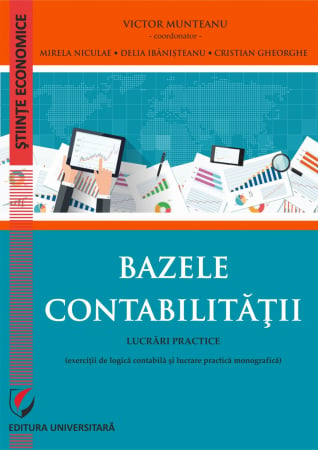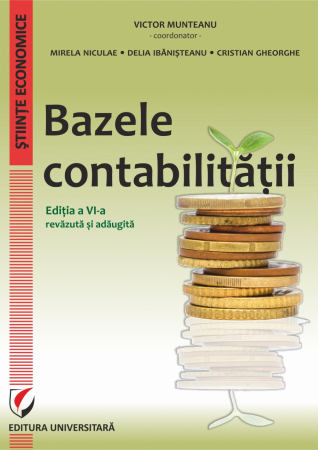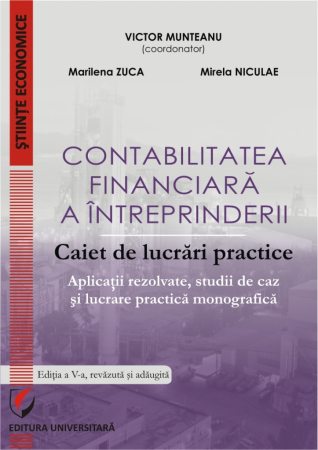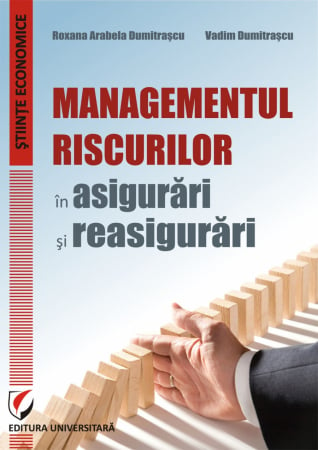Publisher: Editura Universitară
Author: Petrut Cristian Vasilache
Edition: I
Pages: 206
Publisher year: 2023
ISBN: 978-606-28-1739-8
DOI: 10.5682/9786062817398
- Description
- Download (1)
- Authors
- Content
- More details
- Reviews (0)
We live in a global world, where economies and societies are built on the foundations of knowledge-based economy and society. Here, innovation is essential as the driving force for expansion and growth and represents the structure for future development and a precursor to technological advances.
This book contains essential elements regarding how innovative management, innovation, concepts of applied intelligence, technological progress and sustainability are the elements that offer us an advanced empowerment of business and the consolidation of the idea of a developed enterprise, based on the foundation of the economy of the 21st century and on the strong links between man - enterprise - nation - universal progress.
-
Innovative business management in the legal field - Petrut Cristian Vasilache
Download
CHAPTER 1. THE EVOLUTION OF THE MANAGEMENT CONCEPT / 15
1.1. THE EVOLUTION OF MANAGEMENT MODELS / 16
1.1.1. Types of management models / 17
1.1.2. The foundations of neo-Schumpeterian conceptualization / 19
1.2. IDENTIFICATION OF INTERNATIONAL THEORETICAL TRENDS TO ENSURE INNOVATIVE BUSINESS MANAGEMENT / 24
1.2.1. Managerial dilemmas and developed paradigms / 25
1.2.2. Pioneering innovation in management / 29
1.3. INTRODUCTION OF STRATEGY AS A COMPONENT PART OF MANAGEMENT / 30
1.3.1. The concept of strategic pattern / 30
1.3.2. Strategic planning / 32
1.4. KNOWLEDGE DEVELOPMENT AS AN INTEGRAL ELEMENT OF MANAGEMENT EVOLUTION / 38
1.4.1. The emergence of the utilization of available resources / 42
CHAPTER 2. INNOVATION AS A PRIMARY EVOLUTIONARY MECHANISM / 46
2.1. THE ECONOMIC IMPORTANCE OF INNOVATION / 48
2.1.1. Conceptualization of public policies dedicated to innovation / 50
2.2. ECOSYSTEM INNOVATION – AN INTELLIGENT PERSPECTIVE OF HELIX MODELS / 51
2.2.1. The role of governance in smart ecosystems / 54
2.2.2. The innovative Triple Helix model and its derivatives, Quadruple and Quintuple Helix / 59
2.3. THE ROLE AND STRATEGY OF INNOVATIVE BUSINESSES / 62
2.3.1. Innovation strategies in modern business / 64
2.3.2. The relationship between strategy and the functionalities of innovative businesses / 68
2.4. INNOVATIVE MANAGEMENT OF THE FUTURE / 69
2.4.1. The advance obtained through innovative management as an administrative mechanism / 70
2.4.2. Research in innovative management scaled to the rank of science / 74
CHAPTER 3. MANAGEMENT CONSULTING – THE VIEW ON INNOVATIVE BUSINESSES AND THE STRATEGIC CHARACTER / 78
3.1. CONSTRUCTION OF THE PHENOMENON KNOWN AS MANAGEMENT CONSULTING / 78
3.1.1. Development of the consulting industry / 81
3.1.2. Criticism of the business phenomenon called consulting / 82
3.1.3. The change generated by the transformational trends found in the consulting field / 86
3.2. STRATEGIC MANAGEMENT – SOLUTION FOR DIAGNOSING THE NEED FOR CHANGE WITHIN A COMPANY / 92
3.2.1. Optimized strategic management – the path to continuous innovation / 93
3.2.2. Components of strategic management / 96
3.2.3. The levels of innovation found within strategic management / 99
3.3. STRATEGIC MANAGEMENT FOUND IN THE FRAMEWORK OF OPEN INNOVATION / 102
3.3.1. Taking strategic decisions within open innovation / 105
3.3.2. Open innovation control with dynamic capabilities / 109
3.3.3. Limitations of open innovation / 113
3.4. THE CAUSATION MODEL BETWEEN THE PERFORMANCE OF AN INNOVATIVE MANAGEMENT SYSTEM AND THE ECONOMIC RESULTS OF A COMPANY IN THE LEGAL FIELD – THE INFLUENCE OF AUTOMATION AND MACHINE LEARNING / 116
3.5. INNOVATIVE MANAGEMENT IN THE MODERNIZATION OF THE ROMANIAN ECONOMY / 119
3.5.1. Innovative management of the supply chain and the use of Big Data Analytics – the case of Romania / 121
CHAPTER 4. PRINCIPLES AND RULES TO BE FOLLOWED FOR THE EFFICIENCY OF INNOVATIVE BUSINESS MANAGEMENT / 125
4.1. BUILDING INNOVATIVE BUSINESSES BASED ON THE DEMOCRATIC CORPORATE MODEL / 126
4.1.1. The innovative science of applied systems / 131
4.1.2. Applied philosophy as a working mechanism of innovative management / 133
4.2. COMPARATIVE ANALYSIS BETWEEN INNOVATION MANAGEMENT AND TECHNOLOGICAL INNOVATION / 139
4.2.1. Organizational performance and innovation in management / 142
4.2.2. Organizational performance and technological innovation / 143
4.2.3. Tools and rules for innovative management within organizations / 147
CONCLUSIONS AND PROPOSALS / 155
BIBLIOGRAPHY / 166
However, nowadays innovation is a crucial component of competitiveness. It is well established that productivity and competitiveness are influenced by a variety of factors that apply to all social institutions, not just companies. These top considerations should not only be limited to the tangible, but should also progressively support the intangible, the elements that make a difference in the innovative management of modern companies. It is obvious the need to establish an integrated strategy to stimulate innovation in a period of transition to a knowledge-based and innovation-based economy, such a policy is seen as the development or use/adoption of new knowledge as fundamental competitive elements. This perspective on innovation places equal emphasis on the intangible aspects of knowledge and information as well as the tangible aspects of processes, products and services, science and technology, organization and management, primarily involving a change in attitudes, behaviors and even values and social movements and last but not least of the relationships generated. Economic innovation, which encompasses not only enterprises but a wide range of institutions, is therefore intrinsically linked to social and organizational innovation. Firms are, however, the driving force behind this process, and integrated innovation strategies should focus on promoting their own initiative capacity.
Through the inventive efforts that occur within society and the economy, with the involvement of various actors, innovation evolves. These efforts can be public or private and include companies, the state, educational institutions and non-profit organizations. To make innovation models easier to understand, it is useful to establish some key principles. Mainly a distinction must be made between the concepts of technology and innovation, which are often used interchangeably.
Most innovation as a function and innovation management as a process in many companies take the form of small internal improvements to current assets and procedures rather than a drastic change that overturns the status quo. The key feature that characterizes innovation is uncertainty, which results from the nature of the relevant technology and its commercial feasibility. Because information about what is to be achieved is difficult to obtain, technological and innovation management problems that are difficult to solve, and factors that affect the performance of the innovation or invention in the market, all add up and contribute to the unpredictability of innovation. As a result, the company's ability to deliver the desired results will be significantly influenced by the experience and expertise it has previously accumulated through the processes followed, the people recruited and the way of evolution adopted.
The emphasis on the cumulative nature of technology also emphasizes the importance of learning in the process of creating and using new technologies, both in businesses that pioneer innovation through new products or processes, and in those that gain from this innovation only in early stages of the diffusion and dissemination process. Process learning involves "learning by doing", which improves the efficiency of production operations, followed by "learning by use", which improves the efficiency of using complex systems, complemented by "learning by interaction", which involves users and producers in an interaction leading to product innovation and finally through "learning by learning", where a company's ability to adopt innovations created elsewhere (either in a subsidiary or from a completely external source) depends on its learning experience, which is supported by Research and development.
Thus, it seems to be generally accepted that in a managerial and innovative sense the ability of a company to absorb, i.e. to accumulate experience derived from production, the use of inputs, interactions with end users and the accumulation of its own experience, rather than that derived from radical innovations or technological revolutions, it is more important to grow a company using the learning process of innovation as a function and as a management tool. Therefore, companies that are able to build a solid foundation of cumulative learning through the acquisition of skills and experience will be better prepared to adapt to technological change. Finding this information is a difficult endeavor that comes in most situations with a high investment expense (an investment can be considered an expense until the moment it does not provide a positive return in the business in which it is adopted and applied), especially for small, newly created companies that often lack essential knowledge and cannot benefit from established procedures and rules that can speed up decision-making.
In studying the specialized literature for the foundation of this book, it is observed that it is nuanced that, in addition to the connection between scientific advances in academic research and the innovation process, the internal learning of a firm, related to its practices of "doing" and "use", is often the source of an improvement's ability. The mechanics of this learning are extremely important because they involve visualizing problems and diagnosing them at different points in the manufacturing process using tools and technology. In addition to these, the value of two interconnected processes can be emphasized: the internal learning of each firm, which results from experiences in "doing", such as organizing the production process, searching for solutions to specific problems, establishing routines and procedures and using the skills of available human resources and external learning, which is the result of interaction with other businesses, suppliers, users, customers or other institutions (filtered through educational, research and development, training or funding processes).
As a result, stakeholders, academics and sectors consisting of innovative companies will have many opportunities to increase their knowledge, experience and practical skills according to the technological standards of each industry and their potential development as enterprises develop in the process for studying. Moreover, the commercial area of business provides a broad base of perception for innovation opportunities, including opportunities arising from a systematic analysis of the customer, with questions derived from management consulting and applied systemically and separately in innovation management. What does the consumer get for their money? What customer requirements must be met? These questions frequently result in new marketing, distribution, or production methods, as well as evolutionary and innovative product or process advances.
In many sectors, innovation occurs as a result of incremental research carried out by companies, both in terms of goods, but also in work processes and procedures, while radical innovation – denoting a fundamental break with current technology – occurs much less often. Therefore, concerns about innovation frequently focus on the small advances made, overlooking the influence of the market on a company's operations.
So for innovation to succeed, two crucial factors must advance at the same time: the commercial and the technological. These two fundamental dynamics contribute to the highly unpredictable nature of the process that emerges from innovation, which by definition involves the development and commercialization of new innovations. The fact that the development of what is new always includes something unknown and at first unfathomable makes this uncertainty the organizing principle of innovation. Consequently, seeing the innovation process as an effort in managing and reducing uncertainty is vital and valuable.
If one compares the level of uncertainty in companies or the market and the stage of the product life cycle, one can better observe the uncertainty in innovation. As a result, the pace of scientific and technological progress influences the validation of a substantial uncertainty. In the early stages of the life cycle curve of a good or service, changes in product design occur rapidly, and the organization of production and marketing, as well as the search for dominant distribution patterns, are major managerial issues. On the other hand, innovation in the last phases of the life cycle curve of the good or product is usually focused on the process of change, in terms of elements related to simplifying processes and reducing production costs. Meanwhile, the increase in the experience curve is significantly helped by this decrease in costs. While it is generally accepted that uncertainty is a fundamental aspect of any innovation, there are ways to reduce this uncertainty at all stages of the process, particularly through repeated rounds of feedback and by reducing the overall amount of time spent developing the process underlying innovation management .
We live in a global world characterized by a knowledge-based economy and society. Here, innovation is essential, as it is the engine of economic expansion and growth and is the basis for future developments and the precursor to successful technological leaps.
Starting from those presented in this Introduction, we approached the scientific research topic "Innovative Business Management", this being an extensive analysis of how innovative management, innovation, the concept of applied intelligence, technological evolution and the pursuit of sustainability are the elements that make us offers an advanced form of business empowerment and that reinforces the idea of a developed company based on the fundamentals of the 21st century economy and the strong link between man - corporation - state - universal advance. Through this approach, the aim was to fulfill the general objective of the research undertaken by the author in the last decade, namely the improvement of innovative business management in the context of the need for strategic change and operational improvement of the activities of companies operating under the pressure of globalization. The book is built on the basis of four chapters, being built with the idea of bringing to the fore a modern qualitative research on a field relaunched nowadays through accelerated technology of innovative management and which also meets the rigors proposed by the specific objectives proposed, respectively : a) identification of international theoretical trends and current practices for ensuring an innovative and high-performing business management; b) identification of the main sectors of activity in Romania that require rapid, rigorous and well-structured change; c) designing a detailed diagnostic scheme of the need for change, functions and key areas of a company, as well as the necessary procedures; and d) creating a causality model between the performance of an innovative management system and the economic performance of a company.
In chapter 1, entitled "Evolution of the management concept", the modernization of management as a science and as a competitive advantage of companies is brought to the fore. The subchapters of this chapter are dedicated to the generated management models, their typology, the macroeconomic and ideological filter generated by the neo-Schumpeterian parallel brought to the subject, the influences generated within the modernization of the management concept in the 21st century, with all the dilemmas and paradigms generated, including the appearance of the first timid forms on innovation as a pillar of companies' development, complemented by strengthening the study and use of strategy as a strong component of it, including here also strategic planning, but not least the benefits brought by the evolution resulting from knowledge management and the optimization of available resources.
In chapter 2, entitled "Identification of international theoretical trends to ensure an innovative business management", the concept of innovation was brought up as a primary evolutionary mechanism by which the economic component of the development process is understood based on sustainable public policies, summed up in innovative ecosystems based on helix-type models, namely the analysis of the governance necessary for the development of an intelligent mechanism or ecosystem, to which is added the role and strategy necessary for the creation of innovative businesses, everything being filtered through the analysis of their functionality and depth.
In chapter 3, entitled "Management consulting - the vision of innovative businesses and their strategic character", the concept of management consulting, the filter generated within innovative businesses and their strategic character, was brought to the fore, observed from several referential perspectives in order to could outline a 360-degree picture of the complexity of the phenomenon. In addition to the positive component, the criticism of the phenomenon called consulting was also brought to the fore and the need to maintain this field in a continuous flow of change and the optimization of work strategies, all being strengthened and enhanced by the idea of open innovation. At the end of this chapter, an addition was made based on the ideas generated by the introduction of machine learning and automation within companies in the legal field and which work components of these will be enhanced and which of them will be affected. A second qualitative idea was built through the analysis of the modernization of the Romanian economy using innovative management on the sectors of the economy that allow their optimization with such tools, to which is added the decision-making precision acquired through the use of Big Data Analytics.
In chapter 4, entitled "Principles and rules to follow generated for the efficiency of innovative business management", we went on to build and analyze some macro elements related to principles, rules and tools necessary for the efficiency of innovative business management that are up to date with the latest of governance and the democratization of the corporate growth process, to which is added the working filter necessary to create paths with philosophical veleities, thus creating universality through the Delphic teachings. In addition to these elements, the innovative character was filtered from the perspective of management (economic), but also from the perspective of technological evolution (engineering), and the performances generated from the mix of the two representing an effective solution in the century of speed and technology.
In the "Conclusions and proposals" chapter, the emphasis on people as the main resource of companies, the preparation of the executive team within companies to lead for innovation and to guarantee the continuous learning process was brought to the fore, to which is added the need and validation of a appropriate organizational structures and building a company that is adept at the concept of lean innovation and forward thinking in management models addressed in the organization of the future, including by analyzing the limitations of the research carried out, but also by outlining possible future paths for the development of the company's innovative management.

6359.png)
![Innovative business management in the legal field - Petrut Cristian Vasilache [1] Innovative business management in the legal field - Petrut Cristian Vasilache [1]](https://gomagcdn.ro/domains/editurauniversitara.ro/files/product/large/managementul-inovativ-al-afacerilor-in-domeniul-juridic-petrut-cristian-vasilache-253414.jpg)














